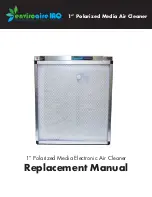
6 Installation
Installer reference guide
17
(A)RXP20~3 RXF20~35A2V1B
R32 split series
4P513661-2 – 2017.11
6.6
Charging refrigerant
6.6.1
About charging refrigerant
The outdoor unit is factory charged with refrigerant, but in some
cases the following might be necessary:
What
When
Charging additional refrigerant
When the total liquid piping
length is more than specified
(see later).
Completely recharging refrigerant
Example:
▪ When relocating the system.
▪ After a leak.
Charging additional refrigerant
Before charging additional refrigerant, make sure the outdoor unit's
external
refrigerant piping is checked (leak test, vacuum drying).
INFORMATION
Depending on the units and/or the installation conditions, it
might be necessary to connect electrical wiring before you
can charge refrigerant.
Typical workflow – Charging additional refrigerant typically consists
of the following stages:
1 Determining if and how much you have to charge additionally.
2 If necessary, charging additional refrigerant.
3 Filling in the fluorinated greenhouse gases label, and fixing it to
the inside of the outdoor unit.
Completely recharging refrigerant
Before completely recharging refrigerant, make sure the following is
done:
1 All refrigerant is recovered from the system.
2 The outdoor unit's
external
refrigerant piping is checked (leak
test, vacuum drying).
3 Vacuum drying on the outdoor unit's
internal
refrigerant piping is
performed.
NOTICE
Before completely recharging, perform vacuum drying on
the outdoor unit's
internal
refrigerant piping as well.
Typical workflow – Completely recharging refrigerant typically
consists of the following stages:
1 Determining how much refrigerant to charge.
2 Charging refrigerant.
3 Filling in the fluorinated greenhouse gases label, and fixing it to
the inside of the outdoor unit.
6.6.2
About the refrigerant
This product contains fluorinated greenhouse gases. Do NOT vent
gases into the atmosphere.
Refrigerant type: R32
Global warming potential (GWP) value: 675
NOTICE
In Europe, the
greenhouse gas emissions
of the total
refrigerant charge in the system (expressed as tonnes
CO
2
-equivalent) is used to determine the maintenance
intervals. Follow the applicable legislation.
Formula to calculate the greenhouse gas emissions:
GWP value of the refrigerant × Total refrigerant charge [in
kg] / 1000
Please contact your installer for more information.
WARNING: FLAMMABLE MATERIAL
The refrigerant inside this unit is mildly flammable.
WARNING
The appliance shall be stored in a room without
continuously operating ignition sources (example: open
flames, an operating gas appliance or an operating electric
heater).
WARNING
▪ Do NOT pierce or burn refrigerant cycle parts.
▪ Do NOT use cleaning materials or means to accelerate
the defrosting process other than those recommended
by the manufacturer.
▪ Be aware that the refrigerant inside the system is
odourless.
WARNING
The refrigerant inside the unit is mildly flammable, but
normally does NOT leak. If the refrigerant leaks in the
room and comes in contact with fire from a burner, a
heater, or a cooker, this may result in fire, or the formation
of a harmful gas.
Turn off any combustible heating devices, ventilate the
room, and contact the dealer where you purchased the
unit.
Do NOT use the unit until a service person confirms that
the part from which the refrigerant leaked has been
repaired.
6.6.3
Precautions when charging refrigerant
INFORMATION
Also read the precautions and requirements in the
following chapters:
▪ General safety precautions
▪ Preparation
6.6.4
To determine the additional refrigerant
amount
If the total liquid
piping length is…
Then…
≤10 m
Do NOT add additional refrigerant.
>10 m
R=(total length (m) of liquid
piping–10 m)×0.020
R=Additional charge (kg)(rounded in units
of 0.1 kg)
INFORMATION
Piping length is the one way length of liquid piping.












































